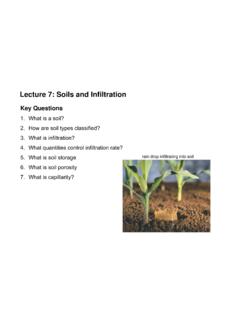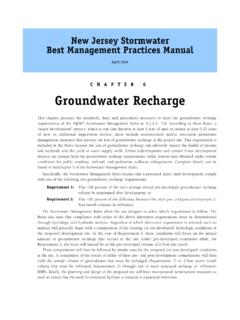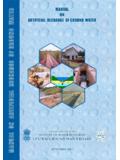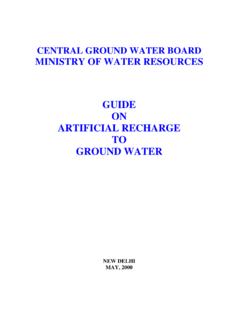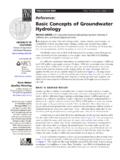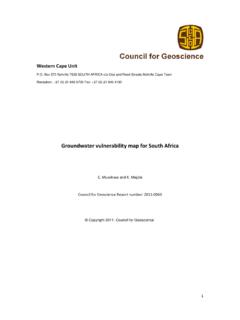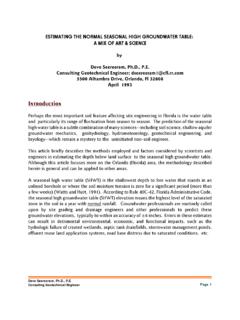Transcription of Lecture 20: Groundwater Introduction
1 Lecture 20: Groundwater Introduction Key Questions for Groundwater 1. What is an aquifer? 2. What is an unconfined aquifer? 3. What is Groundwater recharge? 4. What is porosity? What determines the magnitude of porosity? 5. What causes Groundwater to move? 6. What quantifies the hydraulic gradient? 7. What is hydraulic conductivity? Niigata Japan, 1964 liquefaction 8. What is Darcy's Law? The Hydrologic (or water) Cycle describes the distribution of water among the oceans, land and atmosphere. Read the Groundwater Discharge section rain Hydrograph Q basin characteristics Q (cfs). base flow Q = stream discharge Time Groundwater supports streamflow in between rain events (baseflow). Groundwater Infiltration (and runoff) is controlled by soil type, thickness, original water content, and precipitation characteristics infiltration runoff precipitation ET.
2 Percolation SOIL WATER. runoff . GROUND WATER. Groundwater Recharge = precipitation evapotranspiration - runoff An aquifer is a geologic unit that can store and transmit water at rates fast enough to supply reasonable amounts to wells. An unconfined aquifer is an aquifer that has the ground surface as an upper bound. A confined aquifer is an aquifer that has a confining unit (low conductivity) as an upper bound and lower bound. Unconfined aquifers interact with surface water streams ( , Groundwater surface water interactions). winter instream flow Groundwater surface water interactions water table drops because of lower recharge and/or higher pumping rates (irrigation). summer instream flow Unconfined aquifers are more susceptible to Groundwater contamination A B.
3 Unconfined aquifers are more susceptible to Groundwater contamination. Contaminants are transported by Groundwater flow Groundwater surface water interactions Groundwater contaminants can contaminate streams Water storage in an aquifer is controlled by the porosity Porosity is a measure of void space in a geologic material . volume of voids porosity =. total volume total volume of dry sediment average What controls the magnitude of porosity? 1. Grain shape and packing 2. Grain-size distribution 3. Degree of compaction 4. Degree of cementation 1. Grain Packing cubic packing (loosest possible packing). porosity = n = rhombohedron packing (tightest possible packing). porosity = 2. Grain-Size Distribution uniform grain sizes mixture of grain sizes porosity 40% porosity 25%.
4 3. Degree of Compaction high overburden load low overburden load higher porosity lower porosity 4. Degree of Cementation Calcite and silica cements can bind minerals together and hence, reduce porosity 4. Degree of Cementation Chuckanut Sandstone Aquifer Lummi Island Aquifers What controls Groundwater movement? Groundwater movement depends on 1. The type of geologic material porosity hydraulic conductivity 2. Energy gradients caused by water pressure gravity water pressure pushes . water flows due to a combination of water pressure and gravity pulls . gravity Water pressure pushes and gravity pulls . The combination of these two quantities is called the hydraulic head Water moves due to a difference in hydraulic head between two locations The change in hydraulic head over a distance is called the hydraulic gradient A B.
5 Water has hydraulic head (pressure water has hydraulic head (pressure and gravitational energy) at location A and gravitational energy) at location B. A B. A B. hE = elevation head Datum is mean sea level Note: elevation head is the gravitational head Note: pressure head is the height to which water will rise in a well A B. hP = pressure head hE = elevation head Datum is mean sea level hA = total head = pressure head + elevation head A B. hP = pressure head hE = elevation head Datum is mean sea level hB = total head = pressure head + elevation head A B hP = pressure head hE = elevation head Datum is mean sea level The change in total head ( h) between A and B is what causes water to flow. A h = hA - hB B. Datum is mean sea level A B.
6 Distance between wells is L. The hydraulic gradient between wells A and B is equal to the magnitude of the change in total head divided the distance over which the change occurs. hydraulic gradient = h/ L. hA h = hA - hB hB. h L. water pressure pushes . water flows due to a combination of water pressure and gravity pulls . gravity The hydraulic gradient DRIVES water flow and porous media RESISTS flow friction along the grain surfaces will resist water flow water flows due to a combination of water pressure and gravity The hydraulic conductivity (K) is a measure of the sediments ability to transmit fluid. It's magnitude is controlled by the grain size (or pore size) which determines the amount of frictional resistance and the area available for flow.
7 The units of hydraulic conductivity are length per time ( , cm/s). Water Flow in Porous Media Pore space between grains friction along grain grain grain higher water velocity lower water velocity small area available for flow, low hydraulic condcutivty large grains, large area available for flow, large hydraulic conductiivy The amount of friction along grain boundaries depends on the surface area of the sediment reducing a grains diameter (D) by half, increases surface area by four surface area of a sphere = D2. Smaller grains, means smaller pores, more frictional resistance, and lower hydraulic conductivity Hydraulic conductivity is measured with a permeameter Permeameter Sand filled cylinder (saturated). Cylinder has an area = A.
8 Permeameter water flows through the sand and out the valve water pressure in the vessel pushes . water into the sand Permeameter h L. The volume of water that flows out is controlled by the hydraulic gradient and the hydraulic conductivity of the sediment First Experiment the water height in the vessel remains constant h L. The volume of water that flows out in some length of time is the discharge = Q. Plot the results of the 1st experiment Q/A. h/ L. Second Experiment increased water height h L. larger discharge Q. Plot the results of the 2nd experiment Q/A. h/ L. Third Experiment in all experiments the h is kept constant increased water height h L. larger discharge Q. Plot the results of the 3rd experiment Q/A. h/ L. Darcy's Law Q/A = -K( h/ L).
9 Q/A. slope = K = hydraulic conductivity = permeability h/ L. Slope is K for coarse sand Q/A. Slope is K for fine sand h/ L. Slope is K for coarse sand Q/A. Q/A. Slope is K for fine sand Q/A. h/ L. h/ L. Slope is K for coarse sand Q/A. Slope is K for fine sand Q/A. h/ L. h/ L h/ L. Sand Silt K 1 x 10-3 cm/s K 1 x 10-6 cm/s To get the same amount of Q out of both cylinders in the same amount of time, the h for the silt would have to be 1000 times that of the sand. Slope is K for a sand Q/A. Slope is K for a silt Q/A. h/ L. h/ L h/ L. Saturated Flow in Porous Media average pore water velocity = v = q/n or v = -K/n( h/ L). The average velocity of the water is the Darcy equation divided by the porosity of the sediment.
